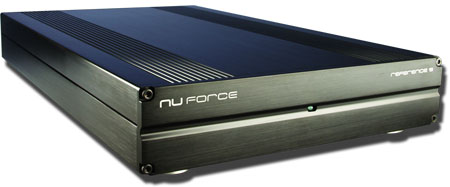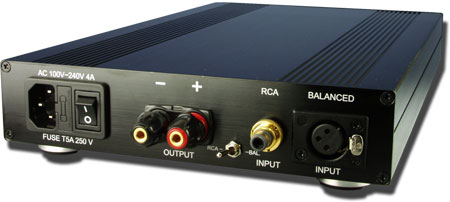I love music. I love not just listening to music, but the whole music experience because there are so many levels and “components” involved in the whole subject. From music composition, to playing instruments, to recording and production, and finally to playing music on component audio systems, the subject is vast, creative, and personal. There is some area for each and every person in which to participate. Regardless of any creative or technical ability, every person can find some music-related activity where their particular talents or yearnings will find an outlet. The fact that there are so many successful endeavors in every area of the musical universe is both a testament to the creativity of our species and absolute proof that every style, every characteristic, every quality of every area of music will find a welcome audience.

I offer the preceding observation to introduce the Nuforce Reference 9 Version 2 Special Edition power amplifiers to you and to prepare you for a set of observations that will likely find resonance with other music lovers, if not the majority.
The main comparison amplifiers are the outstanding Marantz Reference MA-9S2 amplifiers, which are 300 Watt mono blocks. Their linearity, resolution, dynamic abilities, and long term enjoyment have earned them true reference status. To compare the $5,000 Nuforces to $15,000 reference amplifiers might seem unfair, but this is the playing field today at 10 Audio. The rest of the review system consisted of a SOTA Cosmos IV turntable, TriPlanar VII u2 tonearm, Miyajima Shilabe and Air Tight PC-1 moving coil phono cartridges, Manley Steelhead phono preamplifier, a Prism Orpheus studio AD/DA converter used with a Bob’s Devices step up transformer and Pure Vinyl software RIAA used as another phono stage, Cary 306 Professional and Marantz SA-7S1 CD players, and Marantz SC-7S2 and Sonic Frontiers Line 2 SE+ preamplifiers. Cables included Mogami interconnects, Audience Au24 E and Element Apollo speaker cables, Audience, Element and DIY power cords. A PS Audio Powerplant Premier provides the AC for all of the front end gear. Loudspeakers included my reference Dali Euphonia RS3 monitors, Dali Mentor 5s from the home theater system, JL Audio f112 and Velodyne Optimum 12 subwoofers, and little Solid Team speakers from my computer just to cross-check some of the findings below.
These amplifiers sound very differently than any other amplifiers I have heard or can recall. This unique character, just like a particular style of music, will likely find a welcome home with some listeners. This truly is a great hobby that accommodates such diversity. The Nuforces start and stop a note instantaneously, and can go from dead silent to quite loud without any delay. However, the easy feeling offered by the big Marantz amps of unlimited dynamic ability is largely missing and big orchestral crescendos are muted. In addition to this, the differences between the two amplifiers (or four amplifiers, considering they are all monoblocks) are much more apparent than their similarities.
There is a good sense of lateral imaging and also of the volume of the recording venue. The Marantz MA-9S2 amplifiers seem to ignore the physical locations or size of the speakers to create whatever size sound image the music requires. The combination of the Marantz amplifiers and Dali RS3 speakers is less like a stereo system, and more like Holodeck Emitters, creating a virtual soundscape that extends beyond the locations of the speakers. In contrast, the Nuforce’s apparent sonic image stays locked between the speakers and rarely reaches higher than the tops of the speaker enclosures. Many other amplifiers have a difficult time imaging to the left of the left speaker and to the right of the right speaker, but the Nuforces were consistently unable to manage a boundless, sweeping image.
There is a pronounced forwardness in the upper midrange that imparts a coolness to the music, especially to the sound of female vocals. This makes the female part of a male-female duet sound louder and more forward than the male part. This was noticeable on every cut on All The Roadrunning, Emmylou Harris and Mark Knopfler’s accomplished effort (CD, Mercury 9877385). Emmylou’s vocals lost much of their resonant warmth to sound more like an AM radio version. Let me assure you that neither CD player has any problem delivering the richness of Ms. Harris’ vocals, nor those of Rickie Lee Jones, Joan Armatrading, Janis Ian, Sade, or many other female vocalists. This forwardness also places cymbals at the front of the stage, leaving the rest of the drum set several apparent feet behind the speakers. Disconnected. On the positive side, this up-front perspective is complimented by upper frequencies that are completely free from any sense of grit or grain. So even if the upper mids are more prominent, or if the lower mids are relatively recessed, the highs do not acutely offend.

This character makes all music sound cool and just a bit clinical. This often makes sibilants – the “ess” sounds – seem quite sharp and biting, like being hit in the face with a snowball. I am a big fan of Mark Knopfler and Eric Clapton. The Nuforce amp makes them sound like they are much younger, maybe in their 20s, before their voices had developed their current resonant depth. I also enjoy the music of Sting, although he sounds like a teenager through the Reference 9s.
There is good articulation and power in the bass, and a bit better than the ICEpower competition. In every other area, a good ICEpower amplifier, such as a Wyred4Sound ST-1000, is superior to the Reference 9s and at a much lower cost. The Nuforces present more leading edge of bass notes than many tube amps, but compared to the Marantz monos or my memory of the Pass X-250.5 or BAT VK-250SE, the bass is more “thud” than a tight, impulsive punch. Overall, the resolution is very good down to the last 5% or so. After that approximate level, fine detail decreases noticeably. This is likely a contributor to the feeling of very quiet or “black” backgrounds. We often talk about pace and timing. Every listening session included a strange sensation that most bands were slightly out of sync. This did not seem to be frequency related, but the feeling of listening to a tight, cohesive band or orchestra was rare.
Many amplifiers, regardless of price, have the ability to give the listener a strong sense of the air in the recording venue. Smoky, cold, humid, clear, etc., the density and humidity of the space is often apparent. The recording space was consistently presented by the Reference 9s as having a cool temperature with no humidity. Sometimes we get the sense that a 3-dimensional person is singing, but these amplifiers offer a peculiar perspective. Picture a basketball that has been cut in half. We see the ball as a 3-dimensional object, but if the ball is rotated, it is obvious that we are looking at just half a sphere, and the backside is both missing and hollow. Strange. Welcome to my world!
I often found my toe tapping and head moving in time to the music at the beginning of listening sessions, although these signs of involvement disappeared after a short time. The cumulative effect of the cool character, forwardness in the upper midrange and absence of very low level detail was that listening sessions were much shorter than usual, and the presence of listening fatigue often accompanied, or more likely accelerated, the end of the session. I often noticed that I was listening to the music instead of being involved in the music, which is the goal here at 10 Audio. This made listening more of a spectator sport rather than being an active, involved participant and accounts for the final rating.
I am certain that one could assemble a musically satisfying audio system with the Nuforce Reference 9 V2 SE amplifiers. I suggest that it could then be a challenge to find a synergistic replacement.
Overall Rating: 6 LPs
Manufacturer’s Web Site: Nuforce
